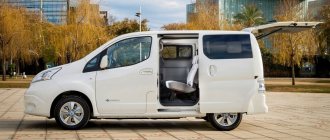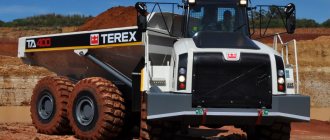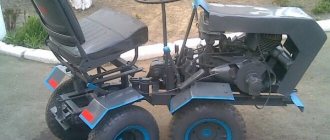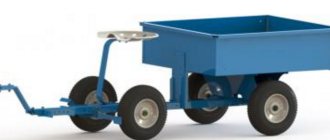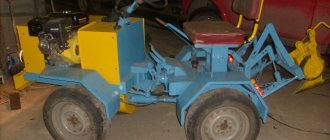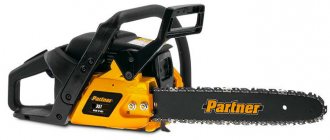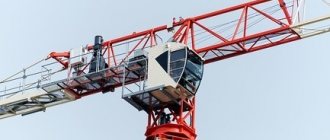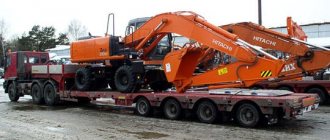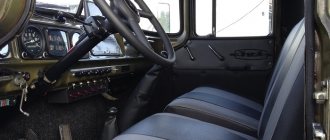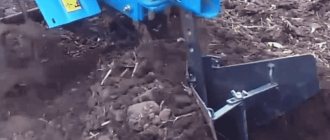- home
- News
- All news
- What is an articulated dump truck
MINING NEWS
| Articulated dump trucks are dump trucks with an articulated frame used on construction and quarry sites where increased cross-country ability and maneuverability are required. An articulated dump truck is a universal vehicle for transporting goods over difficult terrain in harsh climatic conditions. |
Used in the following industries:
- mining industry;
- crushed stone industry;
- construction.
Three-axle models (the most common) of articulated dump trucks have six driven wheels. Biaxial designs (4x4 wheel arrangement) are also used, which are used for vehicles with a carrying capacity of no more than 25 tons. Modern models of articulated dump trucks are equipped with a cross-axle differential switch. Medium-speed liquid-cooled diesel engines with in-line and V-shaped cylinders are used as power plants, equipped in some cases with turbocharging and intercooling systems for charge air. The engines used have an increased torque reserve (20-25%) and meet modern international requirements for environmental friendliness of exhaust gases. The very concept of an articulated dump truck was developed in the middle of the last century (1955) in Sweden. This concept was implemented by Volvo in 1966. And today, the Swedish Volvo Construction Equipment is one of the main manufacturers of articulated dump trucks in the world. The company has already exceeded the figure of 50,000 units of production. Today's articulated trucks provide an excellent operator environment, maintaining high productivity from start to finish of the shift, as well as excellent visibility and low noise levels in the cab; The reliable three-point front suspension provides a smooth and comfortable ride. The load capacity of dump trucks varies from 20 to 40-50 tons. In the world, the production of articulated dump trucks is carried out not by truck manufacturers that produce conventional dump trucks, but by companies specializing in construction and road-building equipment. The articulated dump truck is produced worldwide by companies such as Terex, Caterpillar, Komatsu, Liebherr, Astra, Bell, CNH, Moxy. The Bell company produces dump trucks for Hitachi and John Deere; Astra dump trucks are also sold under the Case brand. In the territory of the former USSR, this type of product is currently produced only in Belarus, where three models of articulated dump trucks with a carrying capacity from 25 to 48 tons were created at the BelAZ Production Association and the Mogilev Automobile Plant.
Cargoautoinfo. Freight transport in detail.
The scope of effective use of dump trucks ends where at least some semblance of a road ends. Where only directions exist, articulated dump trucks, or Articulated Dump Truck (ADT) in foreign terminology, fully reveal their unique qualities.
A real breakthrough in conquering off-road conditions was made in 1966 by Bolinder-Munktell (today Volvo Construction Equipment), launching the world's first articulated dump truck, model DR 631 (4x4). It may have been, in fact, an ordinary tractor without a front axle, articulated with a dump trailer, but the revolutionary concept took root and received worldwide recognition with a circulation of more than 50,000 units over 40 years of production.
Just two years later, in 1968, the three-axle model DR 860 (6x4) appeared with the layout familiar to us today. The regiment of “joint-makers” arrived in 1970: the Swedes were joined by the Norwegians from Moxy (today it is Doosan). In 1974, the first models were released by the British from DJB (today it is Caterpillar). The volume of this segment of the world market is constantly growing both due to increased production and due to new manufacturing companies.
“Do you remember how it all began...” Volvo DR860, 1968, payload 12.3 t
Volvo A40F, 2010, payload 39 t
What is the secret of ADT's popularity? Perhaps, in their indispensability. Articulated dump trucks show the best results in difficult road conditions and complete off-road conditions: on soils with low bearing capacity, steep slopes.
Their operation is economically justified and most effective in the development of deposits, construction and repair of roads, construction of hydraulic engineering facilities, and in various climatic conditions.
Many years of experience in operating machines in extreme conditions gradually “crystallized” the design of the modern ADT.
Frame.
It consists of two welded half-frames connected by a hinge with two degrees of freedom. Such a frame eliminates the hanging or unloading of one of the wheels when overcoming road unevenness, and contributes to the full use of the vehicle’s adhesion weight, which improves cross-country ability. At the same time, the hinge increases the durability of the frame by preventing it from twisting.
Steering.
A hydromechanical system with two actuating hydraulic cylinders rotates the semi-frames at a large (up to 45°) angle, providing high maneuverability. The design of the rotating mechanism is simplified due to the absence of a steering linkage, universal joints of equal angular velocities and rotary axles. Since the front axle wheels are non-steering, there is free space for installing large wide-profile tires, which is very important for increasing the vehicle’s cross-country ability.
Suspension.
The classic version is a front dependent suspension: a solid axle beam is attached to the frame with longitudinal arms and a transverse link; hydropneumatic cylinders are used as elastic elements; The rear bogie axles are also made of one piece, connected to the frame by longitudinal A-arms and transverse rods, and between each other by balancers, which rest on the axles through rubber-metal pads.
Rear grader type bogie
Suspension of the rear bogie on rubber-metal (Terex TA300) and hydropneumatic (BelAZ-75281) elastic elements
Doosan and Hydrema stand out from the general range. Their rear bogies are made of a “grader” type: torque is transmitted through gears inside hollow balancers, and the axles of the bridges can swing with a large amplitude.
Terex uses front independent wishbone suspension from Timoney Mobility Systems of Navan (Ireland) as standard for the TA300 model, and as an option for the TA250 model.
All Komatsu models have a front semi-independent hydropneumatic suspension of the De Dion type; the rear bogie balancers interact with the second axle through rubber cushions, and with the third axle through hydropneumatic elements.
Volvo has introduced its own FS (Full Suspension) system. The balancers and rubber cushions have been replaced by hydraulic struts, which, in combination with hydraulic accumulators and a control unit, form a fully hydraulic suspension with roll leveling function. Thanks to variable characteristics, a comfortable ride is ensured both with a load and when the vehicle is empty. The maximum speed of the A35F, A40F models is 57 km/h!
Engine.
The systematic tightening of environmental standards forces engine manufacturers to constantly improve the designs of power units. In 2006, Stage IIIa (Tier 3) standards came into force, in 2011. — Stage IIIb (Tier 4i), Stage IV (Tier 4f) will enter in 2014. The machines are equipped with in-line 5-, 6-cylinder or V-shaped 6-, 8-cylinder diesel engines with turbocharging and intercooler with a displacement of 6 to 16 liters, power from 230 to 517 hp. “Native engines” are supplied by Caterpillar, Komatsu, Liebherr and Volvo. Astra uses IVECO, Bell uses Mercedes-Benz; Doosan and Terex - Scania; Hydrema, JCB - Cummins; BelAZ-MoAZ - Cummins and MTU.
Astra ADT35: the hinge, the steering cylinder and the platform heating system with exhaust gases are clearly visible
Bell B50D lift capacity 45.4 t - only Doosan MT51 lift capacity 46.3 t can compete with it
A beautiful solution for easy access to the engine from Volvo
High loads at low off-road speeds require the use of a powerful cooling system with a hydraulic fan drive. To improve visibility and reduce the hood, the engine cooling radiator is often located on the side of the engine or even behind the cab. Transmission.
The planetary gearbox with torque converter and retarder is fully automatic with the option of manual shifting. The number of forward gears is 6-9, reverse gears are 1-4. Caterpillar, Komatsu and Volvo make their own transmissions, while other manufacturers use ZF and Allison.
“X-ray” of the transmission and proprietary Volvo Full Suspension
Drive axles with wheel planetary gearboxes, if not our own, then from renowned manufacturers: ZF, Naf, Kessler. Center and cross-axle differentials: self-locking limited slip and with forced locking. Hydraulic brake system with fully enclosed multi-disc oil bath brakes. The operating modes of the transmission and engine are coordinated by an electronic system, which ensures smooth movement and durability. For example, on Volvo F Series dump trucks, ATC automatically selects the optimal combination of differential locks on the fly, allowing the operator to concentrate on the job.
Control.
The location of the operator's seat in the center of the cabin and excellent all-round visibility involuntarily evoke associations with an airplane cockpit. Only there is no scattering of instruments: all information is displayed on the multifunctional color display. The image of the rear view camera and warnings from the vehicle diagnostic system are also displayed there. The controls are located on the circular instrument panel and are within the operator's reach. As a rule, this is a panel with touch pad type buttons and two levers: control of the gearbox and platform lift. The cab frame provides operator protection from falling objects and when the machine rolls over (ROPS/FOPS). For ease of access to transmission units, the cab can be tilted to the side or back.
Dump truck pilot's workplace
Caterpillar Ejector - an alternative "scraper" type platform unloading system
Optional equipment.
Taking into account the harsh climatic conditions of a number of regions of Russia, the vehicles are equipped with an engine pre-heater, a fuel heating system in the tank, a heated fuel filter and water separator, an autonomous cabin heater, and an exhaust gas body heating system.
Options are also provided: a hinged tailgate, additional sides for light bulk cargo, wear-resistant underbody protection, a cargo weighing system, a central lubrication system, engine starting without an ignition key, electronic climate control, heated and electrically controlled mirrors, additional spotlights, etc. d.
Model ranges and manufacturers. Today, ADTs are produced in a range of load capacities from 18 to 46 tons and occupy a niche between dumpers and mining dump trucks. As a rule, each company has 4-5 models with a load capacity of 5 tons. In addition to dump trucks, other options are offered, often with an extended frame: timber trucks, pipe carriers, container ships, superstructures with swap bodies, airfield sweepers, truck tractors and even artillery systems .
The following manufacturers produce ADT: Terex, JCB from the UK, German Liebherr, Danish company Hydrema, Italian Astra, Caterpillar from the USA and Bell from South Africa/Germany. Bell today can also be found under the brands Hitachi in Asia and Australia and John Deere in America. The most serious players in the articulated dump truck market are Volvo (Sweden) and Doosan (South Korea, Norway), as well as Komatsu (Japan). The Belarusian tandem BelAZ-MoAZ is also trying its hand at this market.
Articulated dump trucks have long ceased to be a curiosity; today they can be found in various regions of the planet. They harmoniously fit into the technological processes of construction and at the same time made it possible to carry out work more efficiently in the most difficult road and climatic conditions.
Versatile trolley: articulated wheeled platform
Maneuverability is one of the important parameters of any vehicle. The requirements for high maneuverability are especially relevant when driving on sharp turns and U-turns, when moving between obstacles, for example, along a winding road or in a forest among trees.
It is known that the turning radius of a vehicle (V) is at the intersection of the axes of its wheels. And since the rotation of the wheels of one of the axles (front or rear) is often limited by design features or the conditions of adhesion of the wheels to the soil when turning, to reduce the turning radius, rotation of the wheels of all axles (front and rear - in opposite directions) or a bend in the articulated frame is used. The design turns out to be quite complex, and, accordingly, expensive and less reliable.
The article proposes a solution for creating a frame and an independent suspension system for a wheeled platform, which has the ability to simultaneously “fit” into sharp turns and overcome significant surface unevenness, while maintaining the horizontal position of the “cargo” platform (its frame is highlighted in color in the figure). When a road train consisting of many of these elements moves, its maneuvering occurs along a “snake” - a trajectory laid by the first element.
The problem is aggravated if a road train (or tractor train) is used, consisting of several component trailers or semi-trailers. This is due to the fact that subsequent links move along a smaller radius than the previous ones. To solve this problem, complex steering (thrusting) mechanisms are used, consisting of a large number of rods and rotary levers. Such design solutions are certainly justified for powerful universal machines, but for simple designs they are not economically feasible.
Why not use classic mechanisms that allow you to achieve your goal at minimal cost? An example is the Bennett's articulated four-bar linkage mechanism, or, as it is called, an anti-parallelogram.
Diagram of the hinged antiparallelogram mechanism. The proposed integrated solution for the design of the frame and suspension of the wheeled platform is based on the use of combinations of antiparallelogram hinge mechanisms (Bennett four-link lever mechanisms).
The lengths of the mechanism links satisfy the conditions: AB=DC and BC=AD. The rotation of cranks 1 and 3 occurs in opposite directions, with unequal angular velocities. Gear ratio i13=DE / AE. Point E is located at the intersection of the axis of connecting rod 2 with straight line AD.
The articulated joint of the “breaking” frame used in the proposed solution (see Fig. 3, the links of the hinged antiparallelogram mechanism are highlighted in color).
Diagram of the wheeled platform control mechanism based on the hinged antiparallelogram mechanism.
The lengths of the mechanism links satisfy the following conditions: AB=CD and BD=AC. Links 1, 2, 3 and 4 form a hinged antiparallelogram ABCD. When link 1 rotates around point O, link 4 rotates in the opposite direction around point O1. The rotation of the entire wheeled platform occurs around point P, which is the instantaneous center of rotation.
The maneuverability of the wheeled platform is achieved thanks to the implemented two-axis control scheme, which ensures that the wheels of the rear axle coincide with the track of the wheels of the front axle.
Scheme of changing the position of two semi-frames of a wheeled platform relative to each other.
But if the antiparallelogram has such unique properties, then it is advisable to use it when designing other hinge mechanisms, for example, in a vehicle suspension. Moreover, such a mechanism not only allows you to move suspension elements in a vertical plane, but also turns the wheel in the same plane. This ensures better wheel contact with the ground under special driving conditions, for example, when turning sharply, when the action of centrifugal force additionally loads the outer steered wheel. Accordingly, it rises relative to the frame on the arms of the antiparallelogram and at the same time tilts to the inside.
The wheel suspension of the front and rear axles (each separately) is a combination of three anti-parallelogram hinge mechanisms.
Diagram of operation of wheeled platform suspension elements depending on the position of the wheels relative to the supporting surface.
The joint work of three anti-parallelogram mechanisms makes it possible to compensate for uneven surfaces along which the wheeled platform moves, while maintaining the horizontality of the “loading” platform.
The joint operation of anti-parallelogram mechanisms ensures the preservation of the horizontal position of the “loading platform”, copying the unevenness of the supporting surface with the wheels of the front and rear axles.
The result of the development was the technical implementation of the idea of a wheeled platform with an articulated frame and an independent suspension system, which has the ability to simultaneously fit into sharp turns and overcome significant surface unevenness through the use of an articulated four-link Bennett linkage or anti-parallelogram.
Found a typo? Select a fragment and press Ctrl+Enter.
Tags: Miscellaneous
Previous article Monocrystal or blade for an aircraft engine. The secret of technology for manufacturing heat-resistant alloys
Next article The digital yuan will replace the dollar. What is known about Chinese cryptocurrency
Provided by SendPulse
Likes 0
